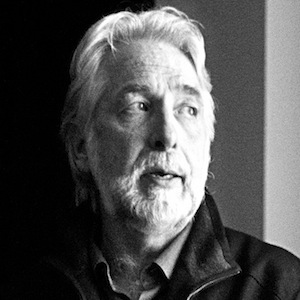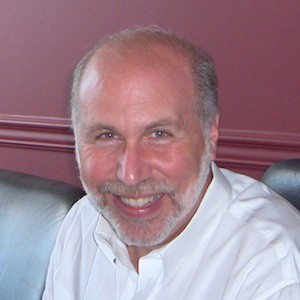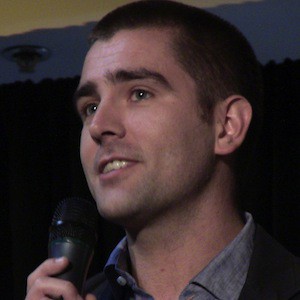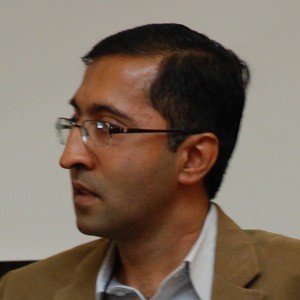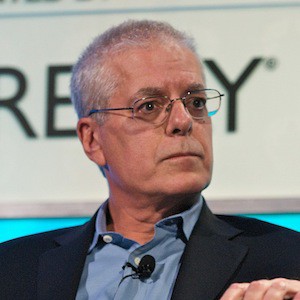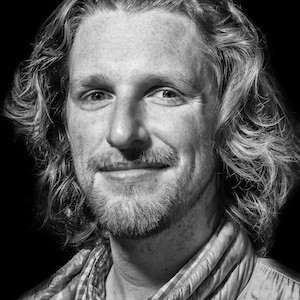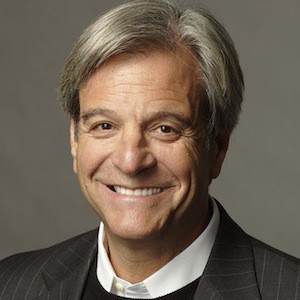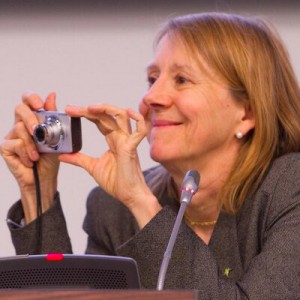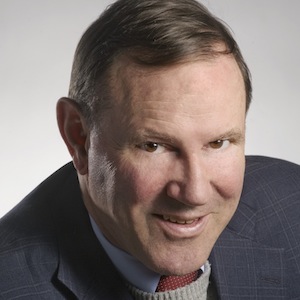Martin Nisenholtz: April 1st, 2013. We’re here at Google with Richard Gingras. Why don’t I start? Richard, you go back about as far as anyone in the world of consumer interactive media, digital journalism. Talk to us about the very early teletext and videotex era. What, from your perspective happened, and what was the learning at that point? You might want to also mix that up with your background a little bit just so we get a sense of the context.
Richard Gingras: Sure. At the time this was 1979. Before that, I had been working for Public Broadcasting. PBS in Washington. I had, in some fashion, come under the wing of Hartford Gunn, who was the founder of PBS. I’m not sure they used the term at the time, but he was really a true technologist. Hartford, who is considered the father of public broadcasting, had really developed it from almost nothing, had built the network from almost nothing. Was always, in spite of PBS’s lack of financial capabilities, managed to hornswoggle the best, latest gear from whatever manufacturers out there would play with him. Sony was among them. He was always on the edge, which frankly was a very important shift in my own thinking about media. I was a young guy out of college. This was all profoundly interesting to me. Hartford, after HBO, was the first to use satellite networking for the delivery of television programs. We built a satellite network for PBS. I worked on that with him, as well. The progression of use of technology was always something on his mind, whether it was the latest low light cameras, even though they weighed 400 pounds, or satellite networking, or, as it turned out, broadcast teletext.
I, at that point, had moved west to California to pursue, at KCET, the public television station there, the use of new technology in expanding the realm and role of public broadcasting. How could public television stations take advantage of additional cable channels, so on and so forth. With that, and with Hartford’s stimulus from Washington, we built a project looking at broadcast teletext. At that time, in context, broadcast teletext was quite popular and already well grounded in Europe, particularly in the United Kingdom, and just starting to develop in some of the other countries, but CEEFAX, the British system, had been in place for several years.
In the United States, at that point, it was looking at the various systems that could be used for this, and there were various manufacturers. At Hartford’s urging, Public Broadcasting, as represented by KCET in Los Angeles, joined together with NBC and CBS to explore these technologies and do a test. We ended up working with the French version of the technology, a system called ANTIOPE, and in late 1979, early 1980, launched the trial in Los Angeles. This was the first effort.
We had also done other technical experiments that the FCC wanted us to do, just for them to help understand how would the use of the vertical interval of the television signal impact, for instance, the proper reception of the television signal on standard TVs, all of this stuff.
We eventually mounted the trial. I had managed to raise money from the Arthur Vining Davis Foundation to do it. We created three services to be tested in several hundred households in the Los Angeles area, so we put all that together. Not surprisingly, KCET’s service was focused more on what we thought was useful news and information. The commercial services did some of that but were also focusing on potential ad related products, as well. I, with a small band, basically, put together this, in a sense, interactive news magazine that you could take and control with a special television set that had this new capability built in.
With a remote control, I could select from any of 100 screens of content. Whether it be the latest news or the latest sports scores. Which given in context, was obviously quite revolutionary. We don’t think of it now. In fact, I recall, several years ago, mentioning this to some young engineers at Google here, who looked at me like, “So what’s the big deal?” What they didn’t recognize was, at that time, for instance, if you wanted the score of the baseball game between the Yankees and the Red Sox at 11:30 at night, you had no place to go.
You could maybe listen to the radio and when they got around to the news cycle, you’d get it. But there was no on demand means. I used to call the sports desk at the local newspaper. The grumpy old guy would answer. I’d say, “Did the Red Sox win?” He’d say, “Five to four.” Which is the easiest way for him to deal with the call besides just hanging up. They wanted nothing to do with it, but nonetheless. So we built these services and they were quite effective. The PBS one in particular was quite effective and quite popular.
John: Can I back up just one second?
Richard: Sure.
John: You had come to this from school. What was your training?
Richard: I was an English major in college who studied, also, filmmaking on the side. I went to Boston College. I did some documentary films. I joined PBS as the assistant to the assistant to the head of programming, who was a guy named Sam Holt, at the time.
John: So you were not a technologist?
Richard: I was not a technologist. I was just a guy interested in media who ended up in that classic role of the day, whatever role you could get into, in the mail room, as it were. Or as the assistant to the assistant to the Vice President of Programming. Get into the business. What you did, what I did, was since my job filing correspondence, was read everything that came through Sam Holt’s office. That’s how I understood what was going on.
Martin: Returning to tele text for just a minute, it fails. Obviously, there’s a window where this is happening. But for whatever reason, probably having to do with the fact that the British license their TV sets, the US market is…
Richard: In my recollection, it failed for the following reasons. Because from a market trial perspective, it was very successful. Our test users loved the product. But this was 1980. We had three competing standards. There was a French system, there was a Canadian system and there was a British system, all competing. Clearly, the set manufacturers did not want to launch with three different systems. This again, was in the earlier era of American telecommunications technology. Where if there were issues like this, then the FCC would step in and help form a standard. But they had, in the late seventies and eighties, begun to drift away from that. Frankly, in 1980, when Reagan was elected, a big push on his part was deregulation. So the FCC further stepped back from taking any role in setting of standards. They, with regard to broadcast tele text, said, “We won’t set a standard. We’re going to leave it up to the industry to sort this out. Let the marketplace decide.” The consumer electronics association stepped in to try to sort out a standard, but could not do so either.
John: So you had Knight Ridder.
Martin: Videotex.
Richard: Knight Ridder, on the videotex side. Some other companies on the videotex side. But particularly with broadcasting, it was important to have a standard. Because manufacturer’s are saying, “What do I add to the set? Which one do I pick?” Interestingly, at that time, important point to recall, we were just in the final throes of the battle between VHS and Beta. Where Betamax, by Sony, was frankly the better quality standard, the better quality system at this point in time. But lost in the marketplace. Really got their hat handed to them, very expensive. Because in introducing new technology like that, you have to forward price to some degree. They did. They lost a lot of money. So the manufacturers were far less inclined to take the risk of saying, “Let’s go forward with three standards and see which ones win.”
That was going to happen. Basically, it fell apart. Not based on market demand, but based on the fact that the set manufacturers just could not see their way through the lack of a technical standard, weren’t willing to take the risk of forward pricing the technology to see which would win, and it basically all collapsed.
Martin: My recollection, Richard, is that particularly on the industry side CBS, NBC, and then to John’s earlier point, the video text trials, these things all basically went away in the early ’80s, early to mid ’80s, and I think industry said, “Well, this doesn’t work. We don’t have to worry about this anymore.” What happened after your tele tex days, what did you then pick up? There were big company, in your case the government, but big company efforts, there was no entrepreneurialism around this.
Richard: No there was no entrepreneurialism around it. Basically, that was the end of that chapter, frustrating as it was. We could see the promise. We were doing things in schools with it, and we noticed a tremendous amount of potential to this technology, but clearly it wasn’t going to go anywhere, which was unfortunate. I interestingly did go off into an entrepreneurial area, but it was a sidetrack. Again, we had identified that the television signal could be used for data delivery. I went off and joined a small company that wanted to use vertical blanking intervals for the delivery of data in various forms, for business uses, and also for some location media purposes. The company had a product, which I developed called Silent Radio, which was basically electronic displays that you would put in places like banks, so people could be amused while waiting in line. Same thing, news, some ads, so on and so forth, in electronic displays. I went around the country, interestingly, at that time, and signed up contracts with 50 television stations and 50 markets to distribute data. That’s what I went off and did during this period of time.
John: Like any English major would.
Richard: Like any English major would. By that time, I had gotten whatever this bug was relating to the use of technology to do interesting things. I don’t know how I knew how to even think about it frankly. It’s not one of those things where I can recall thinking this out and saying, “Oh, plastics. This is going to be big someday.” [laughs] It just seemed interesting to continue to make these progressions in one form or another.
Martin: What year are you in now?
Richard: This part would have been in the early 1980s, ’82, ’83. Then the McIntosh came into play, launched in 1984. A few years later, I’m trying to remember the exact dates, ’85, ’86 or so, Bill, I’m forgetting his name, at Apple introduced HyperCard, Bill Atkinson, HyperCard. HyperCard was this very simple programmatic language that allowed one to create, in a sense, simple information data bases, shared information data bases, and so on, which was really intriguing and caught my fancy. When that happened, I at the time was still working for this data distribution company called Cybernetic Data Products, but was really caught by this new stuff. It had basically begun to hit the market. People were beginning to release software packages based on HyperCard, so I thought, “Why not?”
One weekend I crafted a prototype of a HyperCard based travel information product, which ended up being called City to City. I took this product and I get in contact with Activision, which was a leading software developer of the day, and I said, “I have a travel product for HyperCard and thought you might be interested in distributing it.” The truth is, I had put in about 10 hours of work, had one city that I had glommed together some data, everything was a proof.
Sure enough, they said, “No, we’d be delighted to meet with you. I met with them, and they said, “It looks really great. Can you be ready to ship this in three months?” I hadn’t done squat. I didn’t know quite what I was doing, but of course I said, “Yes.” I finished that product over the course of the next few months. We launched it in January at Macworld.
John: January of what year?
Richard: This would have been January of 19, I’d have to go back and check, but it’s probably ’86, ’87, there about. It was interesting. Of course, there really wasn’t much of a market for travel products on computers, given the fact that there were no laptops. It was a dumb idea, except for the fact that there had been other products out there, and I just sensed there would be some interest in it, and so we did it. That then led, and feel free to cut me off here, that work with HyperCard led Apple to get a hold of me. They thought it was an interesting product. They said, “We’re trying to figure out how to get the Mac into major companies. What we think would work is if we can show how the use of the Mac makes it much easier for executives to use computers in the workplace. Would you design a prototype approach to this,?” And so I did. It was something called Executive Workstation, which was just a very graphical user experience for a group executive office system, calendaring information from various news sources and so on. This again was a prototype, and I had no real clue what I was doing.
I put it together and it worked. It was flashy from a marketing perspective, and Apple loved it. Then again, they took me and we went, the first client for it was Pacific Bell, we went to Pacific Bell here up in Pleasanton, and they liked the product a lot, the Executive Suite. They said, “Great. We love it.” Of course, I then had to build it. Again not…
Martin: Now you’re working for Apple?
Richard: Now it was a private company, I had started a company called Media Works, Apple basically funded us. They said, “Here’s the money. Go forward and build it.” So I built this product, this group calendaring system, again not a trained software developer by any means, but I figured it out. If anyone looked at the code who’s any expert in this area, they would have giggled, but none the less, it worked. This group calendaring, it was a front end to the IBM PROFS email system. I even did initial News agenting software. We would often do, Citi Corp had this service called Global Report, it was an early Bloomberg competitor, that I did a front end to.
Martin: Let’s fast forward a little Richard. I want to get to the Salon work. You then go to @Home, is that correct?
Richard: Yes. Media Works, the recession hit in the early ’90s. It was very hard to sell these systems into major corporations, particularly when the recession hit, so I wound down that company. Then I was first hired by Symantec, Peter Norton Computing. It was a lag. I ended up going to work for Peter Norton and doing the Norton Desktop for Windows. Basically, how do you make Windows, which was the pre graphical user interface, it was basically DOS in the very early version of Windows, and make it more like the Mac? I did that for about two years, and then Apple came back to me, because they were interested in building an initial online service called, “eWorld.” The consumer online space had just begun. CompuServe was out there. I think CompuServe had a couple of hundred thousand subscribers at that time. AOL had licensed a platform from Apple. Apple had an internal mail system called, “AppleLink,” and they had created a consumer version called, “AppleLink Personal Edition,” which Steve Case, they decided not to go forward with that, licensed that platform, and it was with that platform that he built AOL.
And then Apple decided, “Well, maybe we should get into this space again.” We went back to Steve Case, licensed it back from Steve on a deal that would have made him very comfortable if Apple had become the dominant consumer online service, because he would still get paid a per hour rate for anything that come over the network, which was great for him. And we took warrants for six percent of AOL in doing so and built eWorld, which was the first of the more graphical online services. It was basically access to third party information services, all of which had to be custom built for the service, because there was not Internet at that time.
Martin: It’s a walled garden.
Richard: It was a walled garden with a lot of community capabilities. We had chat rooms and large chat events, and so on, and so forth. It was very community oriented. It had a very graphical community oriented metaphor that we built upon that. But the interesting thing there with eWorld at that time, we had actually built it for Windows and Mac, and were about to launch. We were getting ready for launch. I recall it was in the spring. We were launching a few months later, and Michael Spindler, then CEO at Apple said, “I don’t want you to launch it for Windows. I want you to launch it only for Mac. We want this to be special for Mac users.” And I remember that meeting to this day, because it was incredibly deflating, because I realized that we were effectively toast, right? So we launched the product. It did quite well given that it was Mac only. It had 125,000 users in the first years.
John: It was like three percent market share, or something like that?
Richard: Precisely. Exactly. You know, if we would have had Windows we would have had a million users, right, but we did not. So it was a classic unfortunate misstep on Apple’s part. And so in the end Apple’s financial difficulties got worse. This was in the nadir of Apple, and so they decided they had to shut the service down. They couldn’t afford it, and we sold it all to AOL so AOL took all the assets and all of our design motifs and used that for the next version of AOL. Again, when we launched, AOL had 225,000 subscribers so this was very early on. So we sold that to AOL, and then about that time Will Hearst reached out and folks at @Home, and I joined @Home. This was January 1996. So at that time in late ’95, the consumer Internet started to happen. I think CompuServe had just opened up, as it were, a portal to the Internet, and at eWorld we were just beginning to do same for eWorld when we decided to shut the company down. And @Home was obviously the larger vision of saying, “Obviously the Internet is going to be the consumer experience. How can we provide broadband capability?” So I joined @Home as the…
Martin: And @Home is a JV between Excite and…?
Richard: No, at that time @Home was effectively founded by, it was a startup put together by Kleiner Perkins, specifically John Doerr, and TCI, specifically, oh good lord, what his name, John Malone. It was a fascinating board, John Malone, John Doerr, and the heads of other cable companies, just because this was designed to be a venture that was largely owned by the cable companies themselves. You could think of this as Hulu for broadband 1996 with the idea of using the cable infrastructure for broadband, with the idea of @Home putting together a consumer experience, a broadband portal experience, to help consumers get the full value over what broadband was intended to be. It was founded in late 1995. We launched the service in the fall of 1996 in a number of communities. The merger with Excite came two years later in an effort to broaden the portal business of @Home, which, frankly, served to create more friction with the cable operators. Because the cable operators, their real desire here was, “How do we get into this new opportunity of broadband Internet delivery?”
They were far less interested in the notion of creating some aggregate consumer brand, singular consumer brand, that would be across the cable industry. That was against their interest even though the name of the company was Comcast@Home, Cox@Home. But all of the cable companies went and looked at that and said, “Well, that’s diluting our brands and our marketplaces. We really don’t want anything to do with that.”
Martin: So typical consortium problems in the same way the newspaper industry had them with CareerBuilder and other attempts to come together, local regional players into a national…
Richard: Absolutely. Classic. And, you know, I think, frankly, if @Home would have stuck to its core infrastructure premise and promise of, “Here’s the best technology to provide broadband capabilities,” it might still exist today though as an infrastructure supporting institution for cable and not beyond that. Who knows? But certainly, as it sought to become a consumer brand that was perceived to be competitive to the cable brand, then that was quite challenging, and the frictions at the board level and at the @Home cable partner level were pretty intense.
John: That was ’96 so you had RoadRunner at…
Richard: Time Warner was the one cable company that was outside of @Home. @Home had basically pulled together all of the other major companies, but Time Warner had stayed out and went their own route with the RoadRunner effort.
Martin: But it goes public, and you must have benefited from that to some extent.
Richard: Oh, absolutely. It went public. I mean this was an extraordinary experience for me, and obviously a significant wealth building experience for me. No regrets. It was deeply unfortunate that it was clear that it was not likely to have legs given the friction.
Martin: Right. The reason I bring up the wealth creation, Richard, is not to focus on money at all, but to say I think that gave you the wherewithal to begin to think about investing in Salon, which is where I think you really first met journalism head on, right?
Richard: Yes and no. It certainly gave me the wherewithal, but the first funding of Salon is a slightly different story. That actually happened when I was still at Apple. Yes, I was still at Apple. We were winding things up at Apple. The Internet was…
John: What year are we?
Richard: Again, this was the fall of 1995.
John: OK.
Richard: So we could see the Internet start to blossom, and I remember sitting around those days at Apple. Things were clearly coming apart at Apple, but we sat around there, the bunch of us. This was a very talented bunch of people at Apple at that time. You know it was very early stage. Jonathan Rosenberg, who was head of product here at Google for years and years and years, very close friend of mine, worked for me at Apple, worked for me at @Home. Reid Hoffman was a junior product manager in my organization at Apple. People who went off to found PayPal, they’re just smart, capable people. Someone else who went off and was part of Danger with Andy Rubin. And we recognized that the next step was going to be broadband delivery so many of us went off into that era. So we knew the Internet was going to happen. I, at that time, had been contacted by Chris Gaither, I believe it was, and he said he had heard of some folks at the San Francisco Examiner, who were interested in starting an online only magazine, and they were looking for help in getting that started.
So I said, “Fine, I’ll talk to them.” And this was David Talbot, Mignon Khargie, Scott Rosenberg, the early team, they were all at the time at the Examiner. And they came and met with me at Apple, and they said they wanted to start this magazine called, “Salon.” They had some mockups for it. And I, “Well, that’s really interesting,” and, frankly, I think Apple should be interested in this, if not only as simply a marketing expression, right? Let’s get behind new brands and products that are forming here.
And so but I had no money to invest in this, and there were no vehicles that Apple could do that, particularly given the company’s financial state. But, given the company’s chaotic state, I had a marketing budget that had not been expended. So I said, “Look, I’m just going to do a marketing contract with you.” So the original $75,000 that went into Salon was basically leftover marketing money from Apple that I put in their hands along with every computer I could sneak out the back door. That was the founding of Salon. So as I’m always careful to say, I wasn’t the seed investor. I arranged the seed financing, but in truth these were unspent marketing dollars that frankly if the…
Martin: So did Apple technically then own Salon?
Richard: They technically owned, it wasn’t a capitalized deal at that point. It was a loan, which then got converted when Hambrecht and Quist came in and did the first formal investment in Salon. But when I came and I said, “I’ll consider doing this, I figured out how to do it. I brought them back in, and I said, “Here’s what I can do. I can give you $75,000,” and they knew that decision was coming, and they said, “That’s great. We quit our jobs yesterday.” And I remember I went like, “Well, like wait a second. This is only $75,000. This does not go very far.” But, nonetheless, they quit their jobs and that was the start of Salon. And I ended up working closely with them as an adviser just to sort of help them think it through, but, yeah.
Martin: OK, you got through the @Home experience. Is there anything you take away from that experience from a journalism perspective, or is it you’re advising Salon, you’re at @Home?
John: I want to ask it in a slightly different way, as well, while you’re answering, because we’re going to talk to Kinsley later in the week about Slate and Salon. These were, for a brief moment they were the promise, and now we know what we didn’t know coming in here is that Microsoft started Slate and Apple started Salon through the back door. I never knew it. So you have these two fairly significant, hardware software manufacturers deciding to go into the journalism business for online delivery. Why didn’t it work?
Richard: There are lots of pieces to that. I will say that along the way, even, back to the early, broadcast teletext days, and it’s interesting, because we still have these conversations today, what was clear to me in the days of broadcast teletext, was that these different media forms, did indeed require a very different approach to thinking about the use of the media form itself. What we did with broadcast teletext was very, very brief rewrites of stuff. This was being read off your screen, from 8 to 10 feet away. It was a very different form factor, in terms of how one went about this stuff. Frankly, I had those debates with the folks at Salon, at the beginning, “Are you really thinking differently about the media form?” They really weren’t. Obviously, Salon is still around.
Martin: As is Slate.
Richard: As is Slate. But, the audiences were comparatively small. How many people? Even, as late as 1996, we can go back and check, my guess is that the total online population at that point was, probably, not that much more than a million people. This was very tiny audiences. The opportunity to make near term, significant revenues off of a content product in that realm was a tricky one, to say the least. @Home, there too, we began to look at how would this change the technology realm? How would this change the media form? I saw that as part of our role there, was to say, “Part of our role here is really, to showcase what could be different.” The fact that we could use video, when no one else could use video, outside of broadband. We did this thing when Clinton was deposed around the Monica Lewinsky case. As part of that, they released, one day, the videotapes of his deposition. David Wehr was doing some work for us at @Home, at the time. I said, “Let’s play with that.”
We went, and we took all of that video. Very quickly, in 24 hours, cut it into pieces, cataloged it, indexed it, and put it up on @Home such that you could not only see the deposition, but go through the indexes, and find him talking about the blue dress, or whatever it was. It was intriguing to play around with the media form in different ways to understand how it could be used. But, these are still, very early periods.
John: In search.
Richard: Yes. All of these things were in their very nascent state. Salon, at this stage was, again, “Let’s do interesting things with the medium, but connecting the dots between real revenue potential, at that time.” Their bottom line was very, very hard. It was still, very much, about the promise.
John: Slow delivery.
Richard: Comparatively, slow delivery. If you didn’t have broadband, obviously, delivery was very slow. But, it was all about the promise. Salon was able to continue to raise some money based on that promise. Indeed, in 1999, went public themselves, which gives you a sense of what kind of a bubble had, indeed, been forming, around that point.
Martin: I want to quickly get to your work with Google, because, we have about 20 minutes left, and I want to make sure we get a lot of that. But, one of the things that’s very interesting about your background, Richard, is that you’re an English major from Boston College, but you transplant out here. Can you comment on why you think, the culture here, all of the very major technology so called superstacks evolved out here, although Jeffrey Bezos kind of drove out here. What’s going on here that just didn’t take place on the East Coast? In particular, does that matter to journalism, in your view? Is the technology superseding the content at some level? We’ll get to Google in a moment, but, I’m coming to it through a backdoor in a way.
Richard: Why out here on the West Coast? I think, it was simply time and circumstance. Among the circumstances were, KCET was, obviously, in Los Angeles. I moved to the Bay Area to work for Apple, in 1994. Silicon Valley, and, “The Tech Boom,” this was still, very early stages. But, with the formation of the Internet, a couple of things came together. One was, you had this critical mass of very capable people who were here. For instance, as Apple went through its throes, all of a sudden, there were all these folks at Apple, very talented folks, who were clearly starting to depart what was clearly seen as a sinking ship. I mentioned some of the names. The Reed Hoffmans of the world, the Jonathan Rosenbergs of the world, and so on, were coming out of that company looking for things to do. It was clear that the Internet was going to change a lot. It was going to cause change to all sectors. We knew that. It didn’t take rocket science to figure that out. We didn’t know exactly how it was going to play, but, we knew that a lot of stuff was going to happen. You had, of course, at that time, the commensurate formation and growth of the much larger venture capital community. You had the capital, you had available talent, and you had this obvious landscape of opportunity with the Internet.
Martin: That contrasts with the kind of single company, walled garden approaches of the early 1980s.
Richard: That’s right.
John: Also, the central enabling technology, which was the PC, and the Apple, the MAC, were getting a lot more powerful. That business was still in growth mode at that time.
Richard: Absolutely.
Martin: But, in the early 1980s that was not a foregone conclusion. As Richard said, all you needed to do to get tele text and video text services was put a relatively low cost device…
John: Right. But, the time that he’s talking about with the venture capitalists forming, people are starting to leave Apple, now everybody in the country is starting to get computers in their homes.
Martin: Yes. There was infrastructure.
John: It’s not just that you can see that the Internet works, you can see that everybody’s going to be on it.
Richard: Definitely, as the ’90s began to play out, basically, the consumer ended up having a whole lot more reason to want to buy a computer in the first place. Over the course of the ’80s, these were, still, comparatively rare. They grew nicely, but, it wasn’t really considered a consumer device. It was largely an office device.
John: I came through here, about that time, and interviewed everybody, including Steve, sitting over in the next building, wringing his hands, and watching Apple. All anybody talked about, really, in those days, was email. They said, “Everybody’s going to have email,” and instant messaging was about to come on. But email was still considered the reason why you had to have all this stuff.
Richard: Yeah. Even then, in the ’80s, that was comparatively slight, because email systems really did not come into play in the consumer domain until you had services like CompuServe. You had it within the company, but you didn’t have it in the consumer realm. Desktop publishing was one of the first big steps for the MAC, anyway. The fact that you could use this for things like newsletters, printed newsletters, not electronic newsletters.
Martin: You somehow find your way to Google, let’s fast forward a little bit, how does that happen?
Richard: Post @Home, I went into a period of “semi retirement.” I wasn’t sure what to do. I did some investments on the side, I worked with some other small companies that we evolved and developed, and then, I also founded one called Goodmail Systems, which was about certified email. That was my one sidetrack from more media oriented ventures. But I was fascinated with the notion of how you build trust environments in the Internet. Goodmail was a five year struggle, and, eventually, it was four more years than I ever intended to spend in the email business, and I decided to move beyond that. About that same time, folks at Google, specifically Jonathan, said, “Why don’t you come spend some time here? We’re interested in trying to figure out out where the world of television is going, where the world of news is going. You’ve got very relevant experience. Come in, and join us.”
John: What year is this?
Richard: This was in 2007. I worked with Eric, and Jonathan, and other members of the senior team, looking at television, which ended up evolving into Google TV, then looking at the news space. The big question on Eric’s mind was, “As the world of journalism evolves, what could Google do to effectively influence that evolution?” Those are the kinds of questions that we were looking at.
Martin: You came to see us at The New York Times, at a certain point in time. But, nothing really evolved out of that. What is your perspective on that? We’ll ask Eric the same question, but I’d like to get your perspective on what happened. It seemed to have so much promise, when it first started, this venture between the journalistic side and the tech side. You had the engineering, we had the content.
Richard: I think, in a sense, what happened, on our own end, it was this interesting, intellectual exploration of how does the world of media change, and how might one properly influence that? I hope this doesn’t get inordinately complex. But, I tend to think that a lot of us, when we approach a situation like that, that’s chaotic, we want to bring organization to it. We want to bring simplicity to it. Part of our thinking was, “What could Google do to bring together a platform that would help this stuff form in right ways?” There was a lot of goodness in that.
John: What do you mean by, “proper,” and “right ways,” and “goodness”?
Richard: There was a general recognition of, clearly, this was a more open world. Old business models are clearly deteriorating and will not survive. That was quite clear. New models of advertising were evolving. New models of information presentation, and production, and sourcing were evolving. How might one give this structure? One part of the thought process was, “Could one develop a platform that made it easier for independent journalists to produce their own efforts, and group together with others to produce their own efforts?”
Martin: A “Wikipedia,” model, in a sense.
Richard: A “Wikipedia” model from an infrastructure perspective that would let, in a sense, independent voices and brands form on top of that. It wasn’t ever intended to be an umbrella brand. There was a lot of goodness in it. We recognized that there were a lot of things that we could do, from an advertising perspective, or from an advertising platform perspective. Some of that stuff, obviously, did fuel Google’s efforts in the advertising platform sense, and to some extent, in our work with search. But, from a publishing platform perspective, we didn’t move forward with that. It was the general belief, on some folks’ parts, that a, did Google want to get into the business of being a publishing platform versus a much, in a sense, higher level search infrastructure? Did we want to get into the platform business, and might it not be too early to get into any of this stuff, given the rapid changes of technology, and other platforms? Blogging platforms were evolving, and so on, and so forth. For a variety of those reasons, it was decided not to go forward with the publishing platform effort. But certainly, it did continue to inform some of Google’s other efforts that related to publishing, such as, modernization.
John: What about YouTube? You said that you were involved in the television strategies, as well.
Richard: Well, what we were really looking at on the television side was “What was the future of the television set.” Google has always been quite concerned about the hegemony, for instance, that exists between distribution players, and hardware devices. The control of cable over the distribution infrastructure, for instance. The control of carriers in device lock ins in the cellular world. The notion, really, with Google TV was, “How could we enable the full flowering of IP for video, and in a sense, to some extent, bypass the control points of the cable guys?” Thus the notion of saying, “Should there be an operating system for the TV that basically, says, ‘Connect this TV to the Internet, and you’ve got the world of the Internet before you?'” Which, would be a hard thing for the cable guys to control.
Martin: Richard, you’re now in charge of Google. You head up Google News now?
Richard: No. I was an adviser. I didn’t have any operating role. I acted simply as an adviser to Eric, to Jonathan, to Marissa. I worked closely with the Google News team, closely with the forming of the Google TV team. As part of those responsibilities with Eric, is where he said, “Spend time with, The New York Times, and other players. Try to understand more of what we can do there.”
Martin: You’re now employed, right?
Richard: But, then I left. We didn’t do that platform I was looking to do, which was understandable and fine. But, then, at that time, Betsy Hambrecht reached out from Salon, and said, “Can you help us out?” I decided to do some advising for them, and that ended up fueling that. At this point, I had decided that figuring out what was going to happen with news was really, really interesting to me. When I started working with Salon, I went, “Maybe I should actually do this.” I decided to join Salon, and run Salon, to, as much as anything, get my hands dirty trying to figure out, can you make these businesses work? What is hard? What can you try to do, and not to do?
Martin: What did you learn?
Richard: I learned a couple of things. I learned, for instance, that editorial cultures are very, very slow to change. It was fascinating, because, as you know, you’ve heard me speak about this before, I feel like we need to rethink everything, every part of the model. Including, for instance, the approach to the form. Not that I had a specific recipe for what the new form should be, but that old forms don’t necessarily work. Here we are in a world of status updates, and bullet points, and we’re still largely doing 2,500 word articles at Salon, and I looked at the data, and that wasn’t working. Here’s Salon, a digital only company since its founding, still hadn’t really broken out of the box of doing what was largely long form journalism. That to me was a problem. It was very hard, virtually impossible, to change, because it’s funny, when I joined, I said, “We really need to rethink everything,” and everyone said, “Great.” But, when you get down to them, and you say, “What are your thoughts about how you progress with your efforts to cover what Glenn Greenwald covers?” It was a very hard slog.
That was one was, it’s interesting how quick cultural thinking can get deeply set in concrete and resist change, at a time when change has to be continuous and ongoing. That was one. The second was, how hard it was to make money as a news product. The New York Times, obviously, knows this very well. Tiffanys is very comfortable advertising in the front section of The New York Times, and still does in the print edition. Online, there’s no reason for them to do that. They have so many other ways to find their audiences.
Same thing with Salon. It’s very hard to get Lexus, for instance to buy ad space against your hard news coverage. We decided to, expand our areas of soft coverage, because we figured there was more money there. “Let’s do food. Let’s do fashion. Let’s do style,” and so on and so forth.
John: Pestilence, plague, war, doesn’t appeal to everybody.
Richard: The way the ad models work today, is a quest for accurate demographics, and, more importantly, relevance. How do you get them as close as possible to that point of intent where they’re going to make a product decision, a purchase decision? My considering a high end Tiffany watch makes perfect sense if I’m browsing content or areas that are offering luxury products. I’m in the mode to buy stuff. Not necessarily when I’m reading about the latest goings on in the Clinton Administration. It does not really work for the advertiser, nearly as well. We started these soft sections. But, there, too, what I found was, yes, that makes sense, but there’s a tremendous amount of competition there as well. Because, what we have seen with the evolution of the Internet is the tremendous propagation of niche oriented products.
John: Paid search.
Richard: Paid search, which, actually, helps those niche oriented products. It helps the formulation of these niche audiences against very strong commercial opportunities. What I found was that, basically, the challenge that having an umbrella product with lots of sections, may be nice in the old realm of media. But, in the new realm of media, what you’ve got to recognize is that food section of yours is competing head to head with 20 products in the marketplace that are focusing just on food.
Martin: But Richard, isn’t that what the Huffington Post has done reasonably successfully? I mean, they have 70 sections now. They have 50 or 60 million uniques. Part of that is AOL, but I mean, they seem to have done what you were trying to do at Salon. What’s the difference between their presumed success…
Richard: And I think that’s really the interesting question, is presumed success, because what they have done and what one can do is they have basically sort of skimmed the very high level stuff and done it very, very cheaply with an aggregation model. So they’re able to get a lot of traffic and build a lot of uniques. It’s not clear how successful that model is, really, for generating significant amounts of revenue. I think that question is very open. Even at AOL, it’s very open. And I don’t know the exact numbers, but…
John: Also, the cost structure versus the revenue if it’s profitable.
Richard: Right. How HuffPo does, if you look down into their model and say how really are they doing with financial services advertisers versus other dedicated financial service products in the market, I expect we’d find the same thing. I’m not saying that model can’t work. I think it’s open to question as to how profitable it can be, and open to question as to how many of those kinds of vehicles can actually get away with that kind of model.
John: You said something a minute ago. What really drove you back to Salon was your curiosity about where is news going? How is news going to work? Where is the news going? How is the news going to work?
Richard: As I’ve frequently said, I’m very optimistic about the future of news. I’m extraordinarily optimistic about the future of news, but it’s going to be a very, very different landscape. The reason I’m optimistic is because we have these huge open systems. The simple fact that in effect, we put a printing press in everyone’s hands. That’s a hugely powerful thing. You’ve got a lot more people participating in the dialogue than ever before. Doesn’t mean that it’s all good content. It’s not. Obviously not. Still wheat to chaff ratios. But a lot of it is very good. You’ve got a very open system. You also have opportunities, but it does require, as I said, us, when we look at the future of journalism, to rethink all the models, to rethink what is the right way to build a news product in this realm. How do you build audience in this realm? What are the right uses of the media form? What are the right uses of computational journalism? I think computational journalism has extraordinary potential that has not really been fully explored.
Martin: That’s Google News?
Richard: No, I don’t mean computational journalism in that sense. I mean data driven journalism.
John: Data driven journalism, discovering things through analyzing, discovering news by analyzing data?
Richard: Yes, and doing it, frankly, not just in an ad hoc fashion but…
John: Systematically.
Richard: …systematically. The example I often use, and I’ll touch on it here quickly. It’s an example of both how it can work and how adopting these techniques is not easy, necessarily, for existing media organizations. This is, like, 2006. The Washington Post did a classic thing, spotlight section, 30,000 words over 3 days on the state of the D.C. schools, right? At the same time, they happened to have a young intern there by the name of Adrian Holvarty. He went off and founded Everyblock.com, and he built a website off of the work of the reporters that said, “Here are all the D.C. schools and here’s all the data we gathered,” such that you could go into each school and find out what the average test scores were, find out about the state of the facilities, what crime reports had been filed. Everything they could find there, very powerful tool. You could go to the school that your kids were in and get that information.
John: So that’s partly the answer to those who say that the decline of small market, middle market investigative journalism will leave the world open to corruption. Your answer is there’s a new way to find these things, and it’s data driven. My answer to it is, it seems to me, in spite of the evidence that there’s none of this investigative reporting being committed, it seems to me that it’s harder than it’s ever been for people to get away with anything.
Richard: I think there’s truth in that.
John: What can you get away with?
Richard: When I look at that, and to finish my point about the computational journalism with that state of the D.C. schools, my whole point about that is that is actually something that could have been ongoing. That product died. That system that he built died after several months. They didn’t update it. Interestingly, in that regard, I thought it, a, would have been comparatively low cost to update it and it actually had marketing value and ad value because I knew what school you visited. I knew you had kids in school, right? It gave me a lot of interesting data about that audience.
John: Who would invest in a business like that?
Richard: My point is, if you’re a journalism entity in this new realm, then you should look at those models. I think we have not fully explored the notion of, literally, the computational journalist, the guy who’s on your staff who isn’t being assisted by someone over there who’s an engineer, but who, at heart, is a computer scientist and a journalist.
John: Nate Silver is an example of somebody who built a data driven model that somebody who had a distribution system bought into it, and you’ll see that replicated.
Richard: Right.
John: The difference is he’s also a bit of an artist and a journalist and a politico.
Richard: Right. I think there are these new forums that we have not yet evolved that have tremendous potential, in that case for investigative journalism. We have the benefit of this being a far lower cost medium to play in than ever before. You have more organizations playing it. One other point I make is that I think it’ll be a very rich journalistic medium. Yes, we have a whole lot more evolution to go in terms of the creation of the forms. I think we’re also going to have to be more comfortable with a more chaotic journalistic environment because we have gone from the realm where there are a few dominant properties to a realm where there are all kinds of sources of information, some of them pure journalistic models as we knew of them. Others might have more advocacy, which doesn’t mean that they don’t necessarily do good stuff.
John: This gets a little bit into your speech, and some of the things you…What are some of the other…
Martin: We only have a minute left, unfortunately, so you want to do a quick summary?
Richard: Again, I do think, for generalistic purposes, this is an extraordinary time. I do think it’s an opportunity for a renaissance in the exploration of new journalistic forms. We have so many more capabilities available to ourselves. We have it available at very, very low cost. The opportunities for exploration are many and varied. I do think, however, that traditional media entities, that disruption is fierce, and for most of them is not something that they’re going to come out of it in a successful way. It’s the usual, classic rules of disruption. They can’t eat their own young. They can’t think out of the models that they’re already in. The Dallas Morning Herald should not think of itself as The Dallas Morning Herald going forward.
They should look at that new ecosystem and say, “What do we do in that ecosystem in terms of local culture and style content that might add value to our audience? Do they pay for it or not? Political content, do they pay for it or not? What’s our sports product in an aggressive sports market where we know we have great audience? Might not that be free? Might not that be a different brand? What shopping services and sights do we build or acquire as part of a stable of media properties that replace that singular brand that existed before?”
Those are very hard decisions and hard paths to follow. It’s not that folks won’t find success, but, I think, as we have seen in other periods of disruption, it will not likely be the old brands and the old media entities that succeed in this new realm. If the old media entities do succeed in this new realm, it will be as much to do with acquisition as it will to do with transformation of existing properties.
